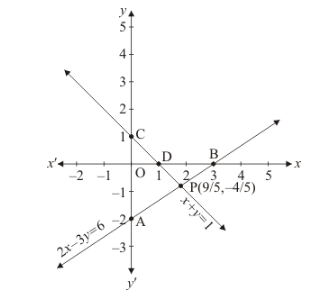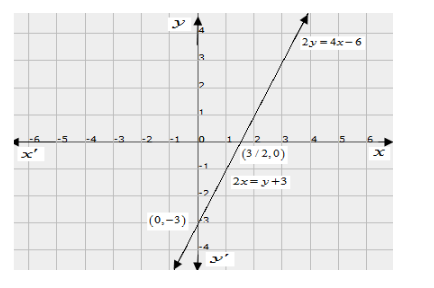Determine, by drawing graphs, whether the following system of linear equations has a unique solution or not :
Determine, by drawing graphs, whether the following system of linear equations has a unique solution or not :
(i) $2 x-3 y=6, x+y=1$
(ii) $2 y=4 x-6,2 x=y+3$
(i) The given equations are
$2 x-3 y=6$$.(i)$
$x+y=1$ $. .(i i)$
Putting $x=0$ in equation $(i)$, we get:
$\Rightarrow 2 \times 0-3 y=6$
$\Rightarrow y=-2$
$x=0, \quad y=-2$
Putting $y=0$ in equation $(i)$ we get:
$\Rightarrow 2 x-3 \times 0=6$
$\Rightarrow x=3$
$x=3, \quad y=0$
Use the following table to draw the graph.

Draw the graph by plotting the two points $A(0,-2), B(3,0)$ from table.

Graph of the equation.... (ii):
$x+y=1 \quad \ldots \ldots(i i)$
Putting $x=0$ in equation $(i i)$ we get:
$\Rightarrow 0+y=1$
$\Rightarrow y=1$
$\therefore x=0, \quad y=1$
Putting $y=0$ in equation $(i i)$, we get:
$\Rightarrow x+0=1$
$\Rightarrow x=1$
$x=1, \quad y=0$
Use the following table to draw the graph.

Draw the graph by plotting the two points $C(0,1), D(1,0)$ from table.
The two lines intersect at point $P\left(\frac{9}{5},-4 / 5\right)$.
Hence the equations have unique solution.
(ii) The equations of graphs is
$2 y=4 x-6$
$4 x-2 y=6$...$(i)$
$2 x=y+3$
$2 x-y=3$..$.(i i)$
Putting $x=0$ in equation $(i)$, we get:
$\Rightarrow 4 x-2 \times 0=6$
$\Rightarrow x=3 / 2$
$x=3 / 2, \quad y=0$
Use the following table to draw the graph.

The graph of $(i)$ can be obtained by plotting the two points $A(0,-3), B(3 / 2,0)$.
Graph of the equation (ii)
$2 x-y=3$.... (ii)
Putting $x=0$ in equation $(i i)$, we get.
$\Rightarrow 2 x-0=3$
$\Rightarrow x=3 / 2$
$x=3 / 2, \quad y=0$
Use the following table to draw the graph.

Draw the graph by plotting the two points $C(0,-3), D(3 / 2,0)$ from table.

The two lines are coincident.
Hence the equations have infinitely much solution.
Hence the system is consistent
Click here to get exam-ready with eSaral
For making your preparation journey smoother of JEE, NEET and Class 8 to 10, grab our app now.
